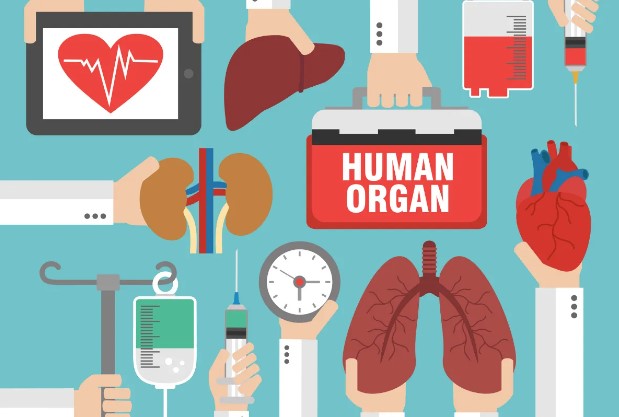Organ Transplantation
Organ Transplantation
Hepatic or liver transplantation is a procedure where a diseased or injured liver is removed and replaced it with a healthy liver from another person, called a donor.
Hepatic or liver transplantation is a procedure where a diseased or injured liver is removed and replaced it with a healthy liver from another person, called a donor.


If the liver is losing its working function it’s called a liver failure and a liver transplant can truly be a life savior (Expectations are at least at 50% survival rate for at least 5 years after the transplant with an acceptable quality of life)
Why is it needed?
Alcoholic liver disease (damage in the liver because of years of excessive drinking)
Liver Cancers (begin in the cells of the liver and not from another organ)
Nonalcoholic Fatty liver disease (too much fat is stored in the liver cells)
cirrhosis caused by chronic hepatitis C
Auto-immune diseases
Genetic disorders

There are three main ways a liver transplant can be carried out:
Deceased donor: the procedure is based on a liver that has been removed from a person who died recently. It’s not allowed for foreign patients.
Living donor: since live is a regenerative organ, a section of liver can be removed from a living donor, both the transplanted section and the remaining section of the donor’s liver are able to develop again to its past state.
Split donation: a liver is removed from a person who died recently and, as the name suggests, is split into two pieces where each is transplanted into a different person.
Crossmatch:
An important percentage of transplant patients are sensitized: having harmful antibodies which will attack foreign organisms including a transplanted organ from a living donor. These antibodies develop through a previous exposure to external tissue (similarly in cases of pregnancy, previous or blood transfusions.)
The waiting period for sensitized patients is always longer since compatibility is a requirement.
Antibodies test is done through mixing the potential donor’s blood and the patient’s blood. This test is called a “crossmatch,” and shows how a recipient’s antibodies react with the potential donor’s ones.
Positive Crossmatch:
The recipient’s antibodies would attach the donor’s which means the organ transplant procedure is not possible in this case.
Negative Crossmatch:
The recipient’s antibodies do not attack the donor’s which means the organ is suitable for transplant.
Paired Liver transplant
Since donors must have a compatible blood type and liver anatomy that is suitable for donation.
Paired Liver transplant might be a convenient option for you if you want to donate part of your liver to someone you know, but you aren’t a good match for that person.
If you want to be a donor, but your blood types don’t match your receiver, your medical team can help you find two other people in a similar situation: one donor and one person who needs a new liver. The donor will have your receiver’s blood type, and the person who needs the new liver will have your blood type.
An interchange takes places according to blood types and solves the problem for both pairs.
Renal transplant or kidney transplant is procedure of placing a healthy kidney from a living or deceased donor into a person whose kidneys are diseased, damaged, or missing.
The main function of kidneys is to filter and remove waste, minerals and fluids from blood. Any disruption in this function would result accumulations inside the blood vessels which would in turn lead to elevated blood pressure and kidney failure in extreme cases.
Common causes for kidney failure:
Diabetes
Chronic high blood pressure
Inflammation and scarring of the tiny filters of the kidneys
PKD – Polycystic kidney disease
Types of kidney transplant
Deceased donor transplant
In case an organ donor dies, their kidneys are donated to people on the transplant waiting list. A person on the waiting list most often receives one kidney, but depending on the situation they might get two. It is not allowed for foreign patients.
Living donor transplant
Since most people have two healthy kidneys and can lead a normal life with just one kidney, suitable candidates can donate a kidney to a person in need.
Living donors can be a Parent, Relative, Friend etc…
ABO incompatible Kidney transplant
In this situation, the patient receives a treatment both before and after the transplant procedure. This treatment aims to lower the amount of antibodies in the blood (Plasmapherisis) which usually cause rejection to the new organ.
And since antibodies play an important role in protecting the body from infections, the body would be injected again after transplantation to avoid any side effects or complications, this phase is known as (intravenous immunoglobulin).
Cross-Over Kidney Transplant
In many situations, having your own donor for the transplantation procedure is not enough because of blood group incompatibility or immunological reasons.
A solution to incompatibility issues is a ‘cross-over kidney-transplantation’. Two donor-recipient pairs are matched for blood group and HLA testing. The kidney of the donor from pair A is donated to the recipient of pair B and vice versa and the two operations should take place at the same time frame.
In a cornea transplant, donor corneal tissue is used to replace a portion of the patient's own cornea. Sometimes this procedure is referred to as keratoplasty. The dome-shaped, transparent surface of the eye is called the cornea. The cornea is where light enters the eye. It significantly affects the eye's capacity for sharp vision.
An eye transplant could:
The majority of corneal transplant procedures are successful. However, there is a slight possibility of complications with cornea transplants, such as donor cornea rejection.
Why is it done?
The most common use of a cornea transplant is to restore vision to someone who has had their cornea damaged. A cornea transplant can also alleviate discomfort or other symptoms brought on by corneal diseases.
A cornea transplant can be used to treat a variety of conditions, such as:
Before having a cornea transplant, you will:
Your chances of receiving a successful corneal transplant can be lowered by unrelated eye issues like infection or swelling. Before your surgery, your eye doctor will take care of those issues.
Results:
The majority of patients who receive corneal transplants will have at least some degree of vision recovery. Depending on your health and the reason for your surgery, you can anticipate different outcomes following a corneal transplant.
Years after your corneal transplant, you're still at risk of complications and corneal rejection. Visit your eye doctor annually for this reason. Medicines are frequently effective in treating corneal rejection.
Correction of vision following surgery:
Your vision may initially be worse than it was prior to surgery. The new cornea needs time to acclimate to your eye. The process of improving your vision may take several months.
Your cornea's outer layer may take several weeks to several months to heal after surgery.
Your eye doctor will make modifications that can enhance your vision once it has healed, such as:
Adjusting your cornea's irregularities. Your cornea may become irregular due to the stitches holding the donor cornea in place on your eye. Astigmatism may result from this uneven surface. The astigmatism can cause blurry vision. Your eye doctor may remove some stitches to treat the astigmatism.
Addressing vision issues. Nearsightedness and farsightedness are examples of refractive errors that can be fixed. Your eye doctor might advise wearing glasses, contacts, or even laser eye surgery in some circumstances.